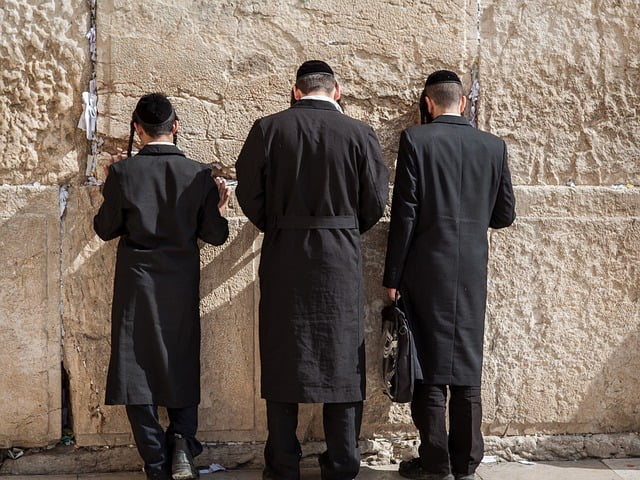
Have you ever pondered why some Jews sway back and forth whilst praying or reading the Torah?
Why don’t Christians practise this, or do they? It appears this action is known as shuckling, and it’s conceivable that Jesus Himself may have engaged in it. If He did, you can be certain the Apostles did as well.
Implications?
This physical movement is most commonly observed amongst Orthodox Jews. The practice is ancient and deeply rooted in Jewish liturgical traditions, though it is not explicitly prescribed in the Torah or Talmud. No one is certain of the origins, but several explanations have been offered within Jewish tradition and scholarship. It’s fascinating to examine these because, as Christians, they have implications for us too.
Some suggest that shuckling is a manifestation of the worshipper’s fervent devotion and emotional intensity in prayer. By engaging the body in prayer, the worshipper expresses total immersion and a physical manifestation of spiritual fervour.
Another explanation gives the idea that the rhythmic movement aids concentration on prayer and study, facilitating deeper focus and engagement with the texts. The physical motion is believed to assist in memorising and internalising the prayers and scripture. It certainly keeps you awake!
A flickering flame…
A more off-the-wall explanation relates shuckling to the motion of a flame, which naturally moves back and forth. This symbolism alludes to the flame representing the soul’s desire to ascend to God. Thus, the swaying in prayer is seen as an emulation of this spiritual yearning, reflecting the soul’s attempt to reach towards the divine. A bit odd, but you may see their point! Historical and practical reasons have also been suggested for the origin of shuckling. Some sources indicate that, in medieval Europe, where space was limited in synagogues, this swaying motion allowed more individuals to squeeze in. Additionally, in cold climates, the movement helped keep individuals warm during lengthy periods of prayer.
Now, some of these explanations are bound to make one smile…
Deep devotion
The concept of shuckling can be appreciated as a meaningful expression of piety and devotion, highlighting the embodiment of prayer and the deep, personal engagement with God. It underscores the ‘whole-person’ nature of worship, involving not just the mind and spirit but also the body, in a heartfelt expression of faith and devotion not far removed from our own charismatic emphasis on experiential, heartfelt worship, and the belief that physical expressions can be a powerful component of one’s spiritual life and connection with God.
God stirs our heart to worship Him, and whilst we might not adopt the entire practice of shuckling, we do raise our hands in worship!
Early Church
Early Christian worship and prayer life emphasised practices such as the reading of Scriptures, preaching, communion (the Eucharist), baptism, and prayer, reflecting the early Church’s efforts to define its identity and practices distinct from Judaism. While early Christians were deeply influenced by Jewish scriptural and worship traditions, given that Christianity emerged from Judaism, the specific liturgical practices and physical expressions of prayer (such as shuckling) were not a focus of their writings. They prayed as they did, but shuckling or not, we are just not informed.
That being said, the early Church Fathers spoke about the significance of fervency in prayer, the posture of prayer (e.g., kneeling, lifting hands), and the engagement of the whole person—body, soul, and spirit—in worship. For instance, Origen, an early Christian scholar and theologian, wrote extensively on prayer, emphasising spiritual and heartfelt connection with God, yet he did not specifically mention practices akin to shuckling.
There is merit in the concept of shuckling. Isaiah 66:2 (a previous post) refers to those who tremble at God’s word. I am not directly suggesting that one should adopt shuckling, but rather, I am advocating for a heart attitude characterised by a deep longing and yearning for God’s presence, to the extent that it feels as though one’s entire being is stirred, provoked, and challenged to pursue God like never before.
Don’t be passive
My friend Paul Cain used to encourage me that I was only ever as close to God as I wanted to be. A passive stance towards God is not an option; our quest for intimacy with Him is, in fact, a Spirit-led invitation—God desires us to draw near to Him. It is then that the allurements of the world begin to fade, overshadowed by the magnificence of Christ.
You may not physically rock back and forth as you worship and read the Bible, but your heart might very well be crying out, “Oh God, Oh God! I yearn for Your presence, Your closeness, Your influence upon my heart and life. Touch me, Lord—help me to grow in trust and confidence in Your Word and Your faithfulness.”
If that’s your heart, it sounds like some great shuckling to me!



